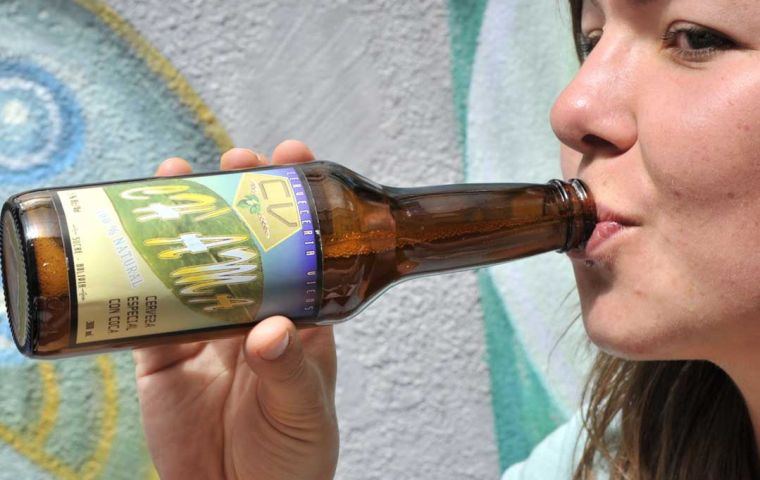MercoPress. South Atlantic News Agency
In Bolivia and suffering from altitude sickness, try Coca beer
 The beer is called Ch’ama or ‘Strength’ in the Aymara language and costs 3.60 dollars a bottle
The beer is called Ch’ama or ‘Strength’ in the Aymara language and costs 3.60 dollars a bottle A Bolivian brewer has come up with an innovative solution for quenching thirst and coping with altitude sickness: coca beer, based on the same leaf used to make cocaine.
Coca has only recently acquired its nefarious reputation: for millennia, people living along the Andes have chewed coca leaves. The juice from the leaves has a mild stimulant effect easing stomach pain and helping people from the lowlands cope with altitude sickness, known locally as soroche.
Visitors to high mountain cities like La Paz -- located 3,600 meters above sea level -- often rest and drink coca tea to deal with soroche. Now there is another option.
The beer in question is called Ch’ama or ‘Strength’ in the Aymara language of the Lake Titicaca area natives. It is made from malt, yeast, hops and soaked coca leaves, with no additives or preservatives.
Coca beer has been produced since 2011 by Cerveceria Vicos, a brewery based in the southeastern city of Sucre.
“This is a highly fermented white beer with five percent alcohol content, unfiltered, un-pasteurized, and has the moderate aroma, color and flavor of coca leaf and hops” Vicos owner and manager Victor Escobar said. He claims the beverage is an “energizing” tonic.
To produce Ch'ama coca beer, Escobar first soaks coca leaves in water, then adds malted barley and hops until the mix reaches its proper consistency. After a 20-day fermentation process, the concoction is bottled.
Cerveceria Vicos is a small brewery, producing 10 hectoliters of coca beer a day.
Retail prices vary, but Ch'ama beer sells for up to 3.60 dollars per bottle. It is sold in Bolivia and towns just across the borders with Peru and Chile.
But what about coca leaves and that nasty illegal drug cocaine?
Cocaine is also produced by soaking coca leaves, but instead of water drug dealers use kerosene, gasoline and chemicals like hydrochloric acid and ammonia. A solution from the leaves is then filtered, refined and crystallized.
Bolivia opposes the use of cocaine, but deplores the demonizing of the coca plant.
President Evo Morales, a former head of the country's coca growers union, is a strong supporter of finding legal ways of using the plant and of rehabilitating its reputation.
Bolivia withdrew from the Vienna-based UN Convention on Narcotic Drugs last year, angry that the coca leaf was labeled an illegal drug. It was readmitted in January after winning an opt-out allowing its population to keep legally chewing the leaves. The coca bush grows exclusively in the eastern slopes of the Andes.




Top Comments
Disclaimer & comment rules-

Read all commentsI seem to remember that many years ago, Coca Cola contained the same constituent. Around a century ago C.C. drinkers got a mild cocaine buzz from 'active' coca leaves. Later it used deactivated coca leaves and, later again, the company replaced cocaine with caffeine.
May 16th, 2013 - 06:14 pm 0The trick wirh Ch'ama is combining coca leaf cocaine with alcohol.
I doubt if the concoction is appropriate for high altitude work or recreational activity;
its likely to be an 'edgy' middle class lad's drink .. straight from the bottle.
Keep chewin', guys!
Commenting for this story is now closed.
If you have a Facebook account, become a fan and comment on our Facebook Page!